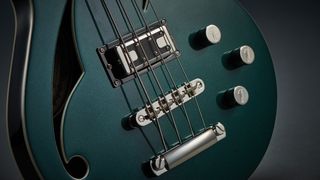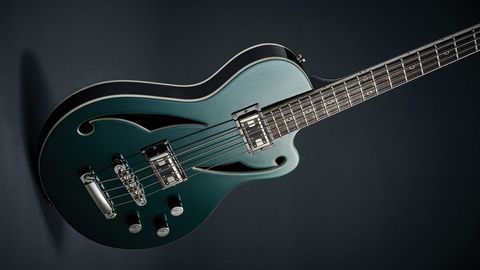The ever-reliable John Hornby Skewes, distributor into the UK of fine gear since time immemorial, has let us have their new Italia bass, and what a beast it is.
More glittery up close than these photos would suggest, the Cavo would seem on first sight to fit most easily into a glam or soul band - although as we always say, there are no rules here. Pick it up, plug it in and let’s have a strum, amici...
Build
Thanks to its chambered body, the Cavo is a doddle to pick up and swing around (carefully...), so anyone sick of barn-door basses will be off to a fine start. If you’re not completely mesmerised by the finish and incapable of movement, check the inside of the body through the F holes - they’re not F shaped, but you know what we mean.
There’s a neat certificate in there, and plenty of room for your picks when (not if) you drop them inside mid-song. A quick look around the bass reveals a very steampunk two-piece bridge that is both solid and accessible, reasonably decent machine heads and a set neck for that 60s vibe.
Two pickups and three pots - volume, tone, pickups blend - keep the chrome-and-green colour scheme simple and attractive. The neck is grippy but manoeuvrable, and the frets are dressed as they should be and smoothly buffed at the ends.
Sounds
The tone you get from the Cavo will be instantly familiar if you’re acquainted with hollow-body basses. Bitey, edgy, punchy, all these words apply: it’s a mids- and top-heavy range that has ‘1963’ written all over it.
Big low end is not available, although you can beef that up with the right preamp if you wish; still, the Cavo tone should cut through more or less any pesky guitar frequency, making it applicable in various environments.
We liked the pickup blend control, detented centrally to let you know when both pickups are at full power: sweeping from full right to full left and back allows you to appreciate the tonal differences between the two units. Both do their job very well, given the limitations of the design and the makers’ obvious intention to produce a vintage-sounding instrument.

There’s no thumb rest, unless you use the top of one of the pickups right at the front or back of the body, so fingerstyle players may need to do the old ‘rest your thumb on the E string’ trick. You can actually use the top F hole as a thumb anchor if you wish, although you might get some funny looks from the rest of the band. It may be a moot point, as it happens, because pick playing is where this instrument really shines. That clicky, Motown sound is just a .80mm bit of Tortex away.
You’ll enjoy playing this bass. Our only caveat is that it’s a touch expensive: you’re not really getting a wide tone range, and the 20-fret neck is obviously not designed for extensive soloing in high registers.
At £779, there’s plenty of competition, so look around before you buy. Then again, that finish and the sheer retro joy of playing the Cavo may make it worthwhile for you. Either way, give it some attenzione.

